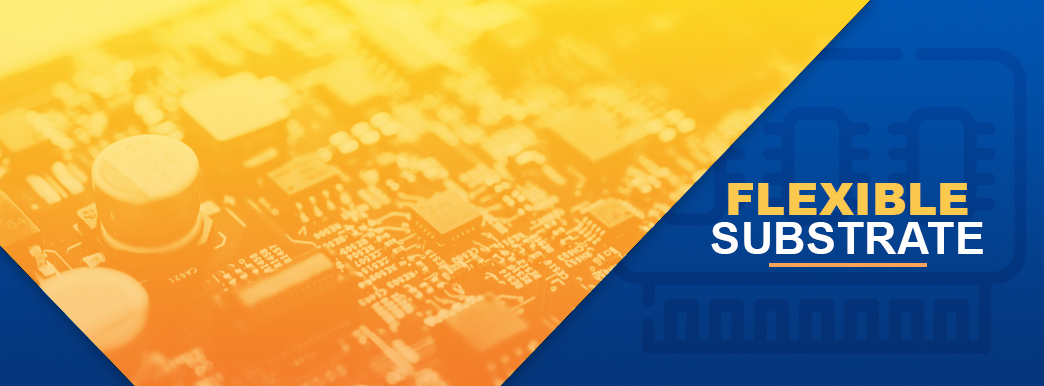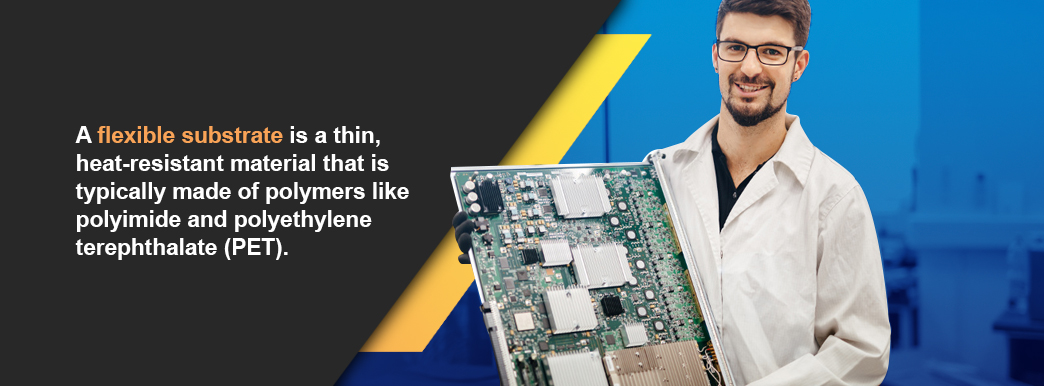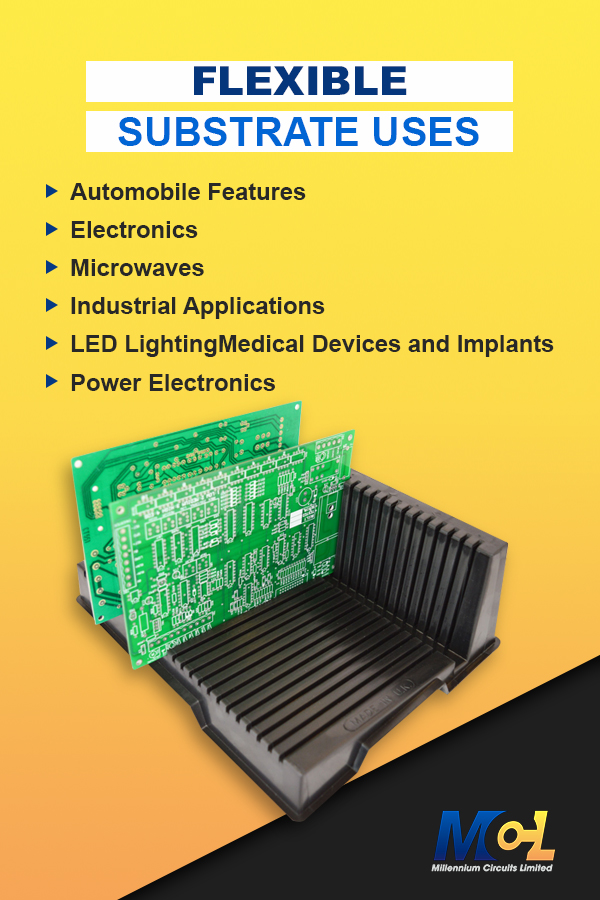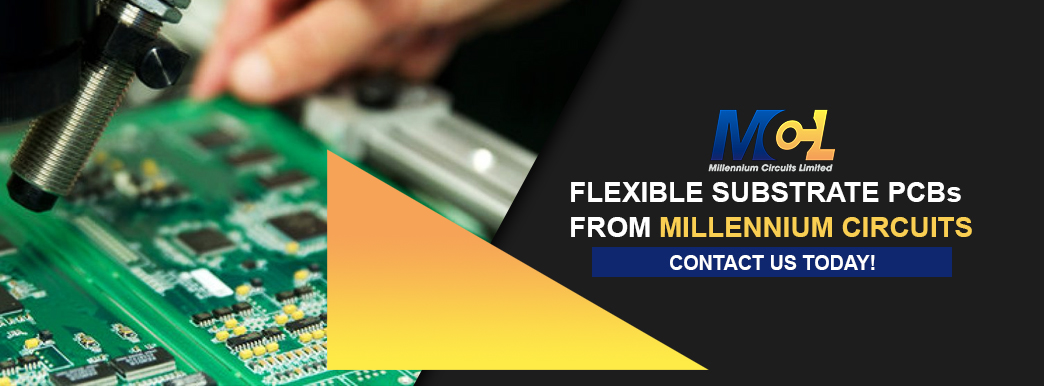Today’s technology consists of complex internal pieces that transmit numerous signals between the user commands and the system memory. As devices become smaller and more advanced, manufacturers require materials that can handle the stresses and demands of various conditions and uses.
In decades past, technology was limited by rigid inner-parts that could buckle under intense levels of stress. In settings where there was too much heat or vibration, any device that contained a printed circuit board (PCB) could easily cease to function. Recently, however, technology has greatly improved thanks to the introduction of flexible substrates.
Table of Content
What Is a Flexible Substrate?
Flexible Substrate Uses
How Are Flexible Substrates Used in PCBs?
Benefits of Flexible Substrates
The Future of Flexible Substrates
Flexible Substrate PCBs From Millennium Circuits
What Is a Flexible Substrate?
A flexible substrate is a thin, heat-resistant material that is typically made of polymers like polyimide and polyethylene terephthalate (PET). In many of today’s computing and electronics devices, the tiny PCBs that transmit signals between the control prompts and screens are often made of flexible substrates.
Manufacturers have increasingly turned to flexible substrates for PCBs because the material has a flexible quality that makes it easier to insert these boards into tight, thin places. Moreover, PET substrate can handle the stresses and temperatures of a vast range of working environments and still provide optimal frequencies with minimal components.
Flexible Substrate Uses
Flexible substrate materials are used throughout the industrial and medical sectors for a wide range of applications and technologies. The flexibility and durability of the material has rendered it suitable for small devices and intense working environments where factors like vibration and high levels of heat often come into play. Some of the primary uses include the following:
1. Automobile Features
The automotive industry is adopting flexible substrates due to the increased reliance on computing technology in today’s automobiles. With the advent of smart cars, automakers need ways to incorporate various smart components into the automotive framework without adding extra weight to the vehicle designs.
With flexible substrates, automakers can equip new vehicles with Wi-Fi connectivity, voice commands and sensing capabilities. Thanks to the low cost of flexible components, automakers can also add these features at reasonable prices. Moreover, flexible substrates can handle the various tremors and vibrations that accompany the bumps and often gravelly terrain of the nation’s open roads.
2. Electronics
With today’s demand for devices that work on the go, manufacturers are making computing and electronic devices that are more compact than ever. These developments have all been made possible by flexible substrate boards, which can be slotted into tiny gadgets that fit in the palm of a hand. Flexible substrate PCBs are used in thin, lightweight devices like smartphones, digital cameras, miniature video recorders and tablets.
3. Microwaves
In devices that generate high temperatures, the components within must have the flexibility and durability to withstand intense levels of heat. For these reasons, flexible substrates have become crucial to the workings of microwave ovens. Each time you heat a cup of coffee in less than 60 seconds, you rely on a set of processes facilitated by flexible substrate PCBs, which transmit the signals from the input pad to activate the microwaves that heat foods and beverages.
4. Industrial Applications
At factories and processing plants, the machines that line the conveyor belts endure vast amounts of stress during a working day. In decades past, these devices relied largely on conventional electricity and compressed air power because PCBs were too sensitive and cumbersome for the stresses of the industrial environment. Thanks to the durability and heat resistance of flexible substrates, industrial machines can now be incorporated with computing technology and perform a wider range of heavy-duty processes.
5. LED Lighting
LED lighting has grown in popularity as an efficient and energy-saving alternative to fluorescent tubes and incandescent bulbs. As with all the competing types of lights, one of the main concerns about LEDs is heat generation, which can waste energy and impact temperature setting in a working environment. Thanks to the heat-dissipative qualities of flexible substrate PCBs, heat has become a non-factor in LED lighting systems.
6. Medical Devices and Implants
Due to the small size and flexible nature of PCBs made with this super-thin substrate, the material has become an essential element of the newer devices used in the medical industry. Flexible substrates are used today in everything from surgical tools to electronic implants.
7. Power Electronics
When combined with thin copper layers, flexible substrates can be used in the industry of power electronics. For the large facility devices that use high volumes of power to operate at maximum levels, flexible substrates are essential due to their stress-resistant durability.
How Are Flexible Substrates Used in PCBs?
Flexible substrates are used to make multi-layered boards, complete with microchips, interfaces and integrated circuits. From the outside, these boards have the same appearance of today’s sleek, simple, unencumbered PCBs. The main difference is that these boards have a flexible quality with significant bending allowance.
One of the other big differences of PCBs made with flexible substrates is the minimal array of components required. These devices can function at high density with just a small amount of surface space. This has made flexible substrate PCBs ideal for small devices that require high-performance capacities for a multitude of functions.
Flexible substrates are used in PCBs because its flexibility renders it resistant to the impacts of tremors, vibrations and intense levels of heat. All the while, flexible substrate PCBs can withstand these stresses with utmost performance capability. In some of the toughest situations at factories and power facilities, flexible substrates make it possible to deliver optimal signal integrity.
PCBs made of flexible substrate function with minimal errors, thanks to the lack of wiring components or mechanical connectors. The assembly methods are also relatively similar on flexible PCBs, which make these boards functional and compatible in a range of applicable devices. Overall, flexible substrates make PCBs more reliable, robust and high-performing. As such, PCBs made of this material have become increasingly favored over their rigid counterparts by today’s manufacturers.
Benefits of Flexible Substrates
Flexible substrate materials offer numerous benefits to PCB manufacturers and the businesses and organizations that use these boards in vast arsenals of complex computing equipment. Flexible substrates render boards less cumbersome and easier to handle, install, uninstall and repair. Moreover, such components are more cost-friendly and less cumbersome to manufacture in the first place. The benefits of flexible substrates can be summarized as follows:
1. Reducing Weight and Space
The reduced size and weight of a flexible substrate make it easier to slot into a vast array of electronic devices. Flexible substrates can be installed in some of the tiniest computing equipment on today’s market. Thanks to the lightweight nature of a flexible substrate, it’s ideal for motherboards in laptops and all-in-one devices. Overall, PCBs made of flexible substrate cut space volume by 50% and reduce weight by up to 90%.
Flexible substrates are also ideal for devices used in the aerospace and medical industries. In hospital equipment, the lightweight quality of a flexible substrate makes it easier to construct more compact yet elaborate devices that can be transferred from one room to another. The lightweight, compact nature of a flexible substrate also makes it the best choice for devices used in the air.
2. Easier Installation and Service
Flexible substrates are easy to install because they can be flexed and bent into place on a printed circuit board. For some of the tiniest boards and devices, the flexibility of the substrates reduces vast amounts of difficulty and labor throughout the assembly process. As such, the costs involved with manufacturing are generally lower when you opt for flexible substrates.
When maintenance or service work is needed, the task becomes a whole lot easier if the device in question consists of parts that are covered with flexible substrates. Just as the material is easy to set into place, it can also be plied when necessary for repairs and modifications.
3. Increasing Reliability
Flexible substrates are more reliable than the earlier options on the market because they require little or no interface connections. With a flexible substrate, you do not have to cope as much with connectors, solder joints, contact crimps and other interface components. Thanks to the massive reduction in connectors, there are fewer possibilities of failure with flexible substrates.
Flexible substrates also have the strength to resist the impacts of vibrations, heat and shocks. As such, the substrate is suitable for boards used in devices meant to cope with extreme temperatures and turbulence. With flexible substrates, most devices will generally have the strength to withstand grueling military and medical uses.
4. Managing Heat
Flexible substrate materials resist heat and also offer vastly superior flexibility to all the competing options. As such, device components equipped with flexible substrates are more suited to withstand the stresses of high temperatures in industrial settings and humid environments. Flexible substrates can also resist the effects of temperature changes that often cause other materials to expand and contract over time.
Due to the temperature resistance of flexible substrates, the material is also largely resistant to the effects of gas, oil and acid. Additionally, flexible substrates are mostly resistant to the effects of UV exposure and radiation.
5. Improving Aesthetics
Flexible substrates have a sleek and transparent appearance that makes the pieces inside of electronic and computing devices more aesthetically pleasing and easier to identify. In older components, the internal parts were often encumbered with wires and other components, making them hard for the typical layperson to identify.
In newer components, the sleek appearance of flexible substrates renders components less intimidating to the average users. In various organizations throughout the industrial sector, computing staff and IT personnel can instantly identify various pieces that use flexible substrates because the parts are not covered with wires and through-hole components.
6. Eliminating Connectors
Flexible substrates largely eliminate the need for interface connections on computing or electronic components. At the same time, flex circuits can accommodate most types of components, as long as the pieces are applicable to rigid PCB design. Integrated zero interface force (ZIF) contacts offer easy small-part interfaces that work in system infrastructures.
Boards that are layered with flexible substrates are generally flat in nature and sleek in appearance. Due to this flatness, PCBs with a flexible substrate can more easily be inserted into narrow slots in some of the tiniest devices imaginable thanks to the lack of complicated connectors.
7. Reducing Assembly Costs
Due to the thin nature and lightweight quality of flexible substrates, the material is easy to apply in a confined area. Therefore, the cost to manufacture components with flexible substrates requires relatively little in the way of overhead. Moreover, the costs associated with materials and packaging are also reduced when flexible substrates are used for the components at hand.
The Future of Flexible Substrates
The use of flexible substrates is expected to increase in the coming years in the areas of electronic memory, microelectronics and optoelectronics. PET substrate materials offer the flexibility and durability ideal for further advances in the technology used of the control of light, signal transfer and memory storage in the realms of computing and electronics.
For computing equipment, PCBs made of flexible substrates will allow for greater amounts of memory storage in tiny computing devices. In due time, manufacturers could turn out thumb-sized devices with the capacity to store thousands of high-bitrate movies and the processing power to run multiple programs, each at the prompt of a voice command. These devices could be compatible with wall-sized screens that display in full color and optimal resolution, complete with built-in surround-sound speaker systems. All these features will likely be controlled remotely with voice-activated AI technology, all made possible by flexible substrate PCBs.
PET flexible substrates will also facilitate further developments in smart cars. If driverless cars take over the nation’s roads in the coming decades, flexible PCBs will be integral to the memory power, sensing technology, artificial intelligence and remote connectivity of such automobiles. The same technology could also be used to power flying vehicles that could ultimately reduce the public’s need for roads and bridges.
Flexible substrate materials could also be integral to predicted technologies like robot maids and delivery drones. As the public becomes less car-reliant and businesses expand their reach via the internet, customers will be able to order take-out meals and apparel from restaurants and shops located many miles away, all thanks to drones that will likely operate on the high capacity, stress-resistance and durability of flexible substrate PCBs.
Flexible Substrate PCBs From Millennium Circuits
As more manufacturers learn about the benefits of flexible substrates and their use as a material for printed circuit boards, more and more product makers are switching over from the rigid materials of the past. With flexible PCBs, even the smallest and thinnest devices can easily be equipped with power and durability in superior capacities to their larger counterparts. At Millennium Circuits, we provide a range of flexible circuit boards. Contact us today to learn more about the capabilities of flexible substrate PCBs and how they could benefit your devices.






